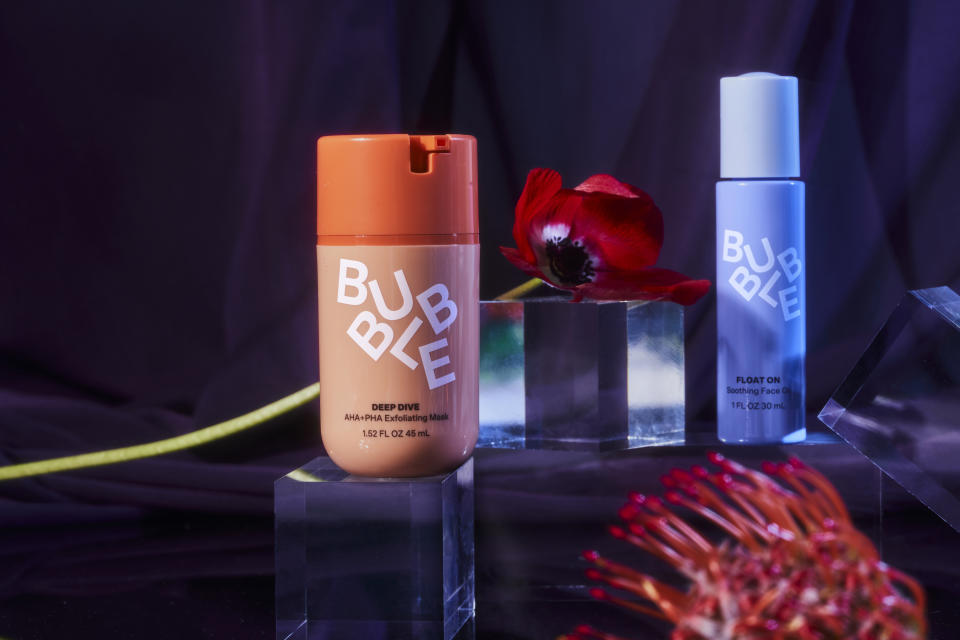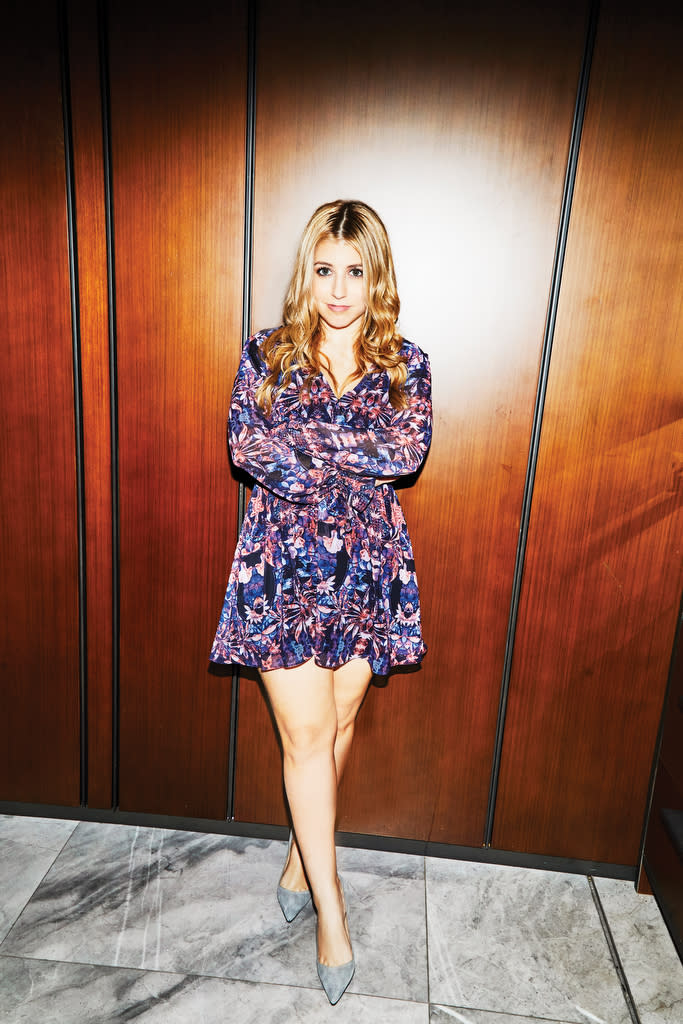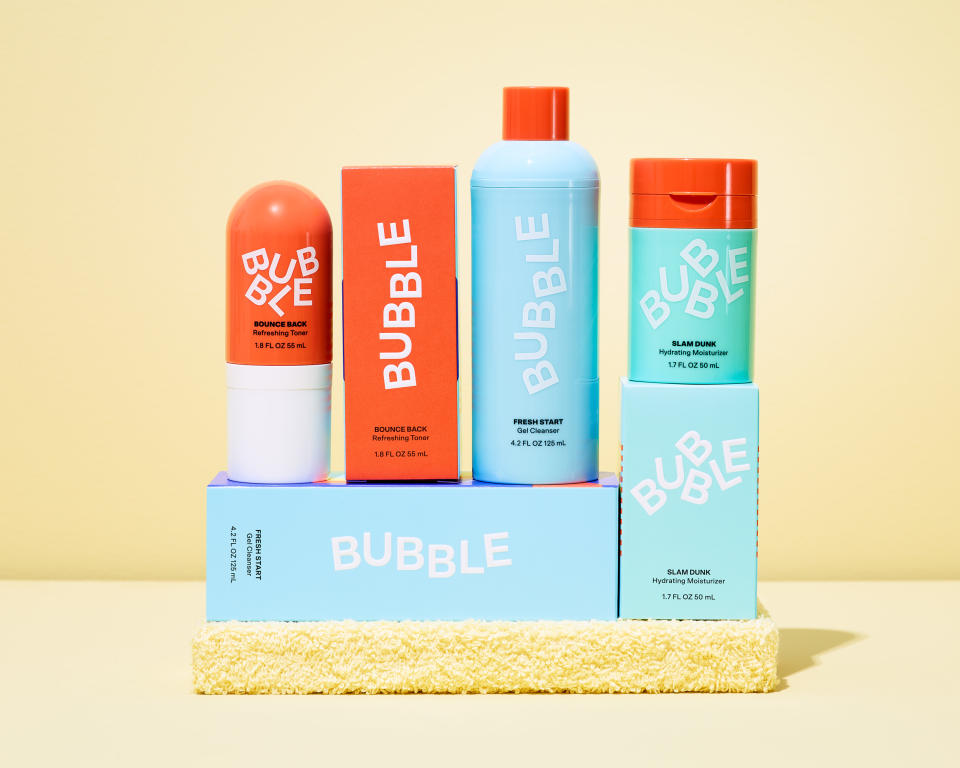How Shai Eisenman Built Bubble
- Oops!Something went wrong.Please try again later.


Photo courtesy of Bubble
More from WWD
Innovation-driven and democratically minded, Shai Eisenman’s Bubble is beginning to swell.
The skin care brand is in expansion mode, taking its accessibly priced, clinically formulated approach to new categories and new retailers. The brand is launching with CVS Pharmacy this month, in between a cadence of launches including a clearing face mask called Deep Dive, a face oil called Float On, and an over-the-counter acne product to come in the coming weeks.
And it’s getting the word out with an unorthodox approach to marketing, tapping a new generation of voices and personalities — like Minnesota Viking wide receiver Justin Jefferson — to act as brand ambassadors, rather than the standard lineup of young celebs.
That strategy dovetails well with Bubble’s value proposition of modernizing traditional solutions to acne, geared largely toward Gen Z. “We like to call it the modern answer to old-school skin care problems,” Eisenman said. “We wanted to create something that is different, something that first and foremost is going to empower consumers to feel confident in their own skin, and more than that, we wanted to create a brand that consumers could emotionally connect with and also had the best possible efficacy and clinical results, all while still maintaining the same price points that they’re used to paying.”
The emotional piece of the puzzle also defines Bubble’s purpose-driven initiative, which is focused on mental health. The brand offers customers 50 percent off their first month of online therapy on the teletherapy platform, Betterhelp, and donates 1 percent of proceeds to mental health charities.
Eisenman, a 30-year-old serial entrepreneur, started her career in tech, but turned her attention to skin care when she realized that while consumer needs and preferences have shifted, the market — and the innovation behind it — had not.

Amy Lombard/WWD
“Young consumers today are the most advanced generation that’s ever existed, but when you look at mass market skin care, it truly hasn’t evolved in 50 or 60 years,” she said. “So much of this market has been controlled by old-school brands, brands that consumers are not emotionally connected to. You’re not going to hear the average 19-year-old saying, ‘I’m so happy I got this drugstore brand for my birthday.’”
Bubble launched direct-to-consumer in 2020, just after the pandemic spurred concerns about “mask-ne” and ignited excitement in the category with a cleanser, toner and moisturizer. In 2021, it extended its reach, inking its first retail partnership with Walmart. At that time, industry sources estimated Bubble to reach $20 million in sales for 2022. Sources now estimate the brand will reach between $20 million and $30 million.
Despite her target audience being the first digitally native generation in history, brick-and-mortar distribution is key to Bubble’s growth. “Accessibility is everything,” Eisenman said. “Based on the research that we’ve done, 80 percent of Gen Z are shopping for skin care in-store, 58 percent of them are shopping for skin care in big-box retailers. Around 45 percent of them go to drugstores.
“We really want to be wherever our competitors are. Accessibility is a major part of our consumer behavior, and we know that consumers are interested in buying products in-store and that we needed to be in drugstores,” Eisenman continued. “To quote one of our most beloved community members, what can be better than buying your lemons and your skin care in one store? This is how they see it,” she said. “They love going and picking it up whenever and making it very easy to make one trip and get everything they need.”

Photo courtesy of Walmart
Those consumer insights have helped shaped the strategic direction of the brand, with Eisenman and her team tapping into social listening and a 10,000-strong focus group of teens to build Bubble.
“[Bubble consumers] have been a part of and have shaped every decision you see of the brand: they chose their name, they chose the packaging,” Eisenman said. “They chose the names for Deep Dive and Float On, and about 50 of them tested the formulations before we approved them. They are really a part of every decision of the brand, and the way we’re building our product road map and our retail strategy is based on their feedback.”
The expansion into CVS also comes at a pivotal time for that retailer. In July, it christened the Skin Care Center, a solution-focused, clinically minded shop-in-shop concept that also marked its foray into prestige beauty. CVS’ chief merchant, Musab Balbale, hails from Walmart, where he modernized that retailer’s beauty assortment with brands like Bubble and Sharon Chuter’s Uoma by Sharon C.
CVS’ strategy also involves leaning into its health and wellness expertise. Andrea Harrison, vice president of beauty and personal care, told WWD in an interview about the Skin Care Center, that “most customers put skin care really close to self care, and certainly close to health care. Given our role that we play as a trusted health and wellness destination, that’s a piece of the story we need to make sure we offer.”
Color-blocked packaging aside, that philosophy jives well with Eisenman’s vision for her brand. “We are focused on creating and getting the brand to be very, very clinical, and we created the brand together with dermatologists,” she said. “It took us over two years to create each formulation, and efficacy is everything to us. It’s something that still needs to be educated at mass — pretty and cute packaging doesn’t necessarily mean that the products are not clinical.”
Eisenman added that Bubble works in tandem with a dermatologist, a team of cosmetic chemists and, when appropriate, a clinical herbalist on all new products. “We take a holistic view of efficacy,” she said. “A big goal of our product is around clearing your skin, and creating products that are going to truly clear the skin while maintaining a very natural balance.”
Consumers aren’t just focused on acne products, though. Although skin care is Bubble’s specialty, Eisenman said requests from Bubble’s followings range from makeup to merch. “The things that have surprised us the most really tie back to that emotional connection. They’re asking for merch, and it’s a nice surprise that it’s more than just skin care for them, that they connect with a brand enough to wear a hat that says ‘Bubble’ on it,” Eisenman said.
“The other thing they’ve always asked us for is to create makeup, a surprise because we’re such a skin care-focused brand,” she continued. “We also really want to stay gender-neutral. We’ve always been gender-inclusive, so it’s interesting to see the consumer evolve in that direction.”
Makeup isn’t in the works for at least the next few years, as Eisenman hopes to appeal to Bubble’s broad consumer base with all of its new products. The brand’s consumers, at least online, skew surprisingly male.
“Forty percent of our community online are actually guys,” Eisenman said. “That’s one of the reasons we first went with Walmart. We wanted to be in a place that doesn’t feel very gender-specific, and a lot of guys would not feel comfortable going into a prestige beauty retailer. That was a big part of the decision.”
The men who buy Bubble gravitate toward the basics in regimen-building. “We have a very heavy focus on acne within our male community. They’re very focused on the cleanser and having a base routine with a moisturizer. We’re trying to educate them on exfoliation as well,” Eisenman added.
Bubble’s approach to education has also evolved, giving Eisenman a new imperative to rethink influencer marketing. “We started conducting focus groups in late 2018, when all of our consumers were really focused on watching makeup-focused YouTubers. It was interesting to see the evolution of leaning into skin care,” she said. “Consumers are significantly less influenced by influencers these days. It was something we saw in the beginning, and it’s evolved into listening to friends and dermatologists. We call it ‘one-on-one’ marketing.”
With that in mind, picking unconventional brand ambassadors has struck a chord. “We work more with athletes than traditional talents. We want to open the brand to different audiences who haven’t been the most common audiences for skin care specifically. We see skin care as personal care, you should be using your cleanser exactly like how you would use shampoo.”
Most recently, Bubble tapped Justin Jefferson, the 23-year-old Minnesota Vikings wide receiver, as its spokesperson. “This was a good, fun partnership for me,” he told WWD. “Just being on camera all the time, I can’t have rough skin.”
Jefferson’s needs don’t differ greatly from Bubble’s male consumers, and the brand’s mission resonated with him strongly. “I wasn’t a big skin care person before, so I’m just trying to explore all of the products,” he said. “They’re affordable, they take mental health seriously…we have some content rolling out over the course of our partnership that you’re seeing coming to life on social media.”
Bubble’s ambassador program has been both a great educational vehicle and an effective lever in a fiercely competitive market. “That’s been really amazing at driving trial and introducing friends to the brand,” said Eisenman. “Brand loyalty is decreasing in levels that have never been seen. We want to find partners who are really passionate about our products, and also about the mission of making the best quality skin care truly accessible.”
Competition in the dermatologist-developed drugstore space is heating up. Last year, Galderma-owned Cetaphil announced it would be reformulating its hero products for the first time since the brand’s launch 74 years ago; Cerave was given a second life after TikTok virality pushed sales to around $600 million in 2020, according to industry sources.
“The market has never been this saturated, and there are so many new brands coming into the market,” Eisenman said. “One of the things we know we struggle with is how to get people to trust a new brand, when the brands they’re using are 30, 40 and 50 years old, being used by their parents.”
Eisenman is upping the ante on product development. One example is Bubble’s new Daydream serum, which combines vitamin C and niacinamide and is priced at $17. “We saw in our community was that people like to apply both of those ingredients simultaneously,” Eisenman said. “That took a lot of testing and consulting a lot of different chemists to nail the composition and make a very stable product.”
Recent launches include Float On and Deep Dive, a face oil and an exfoliating face mask, priced at $18 and $19 respectively.
“We wanted to create something that feels more gentle while still exfoliating the skin,” Eisenman said. “Then, you have this really light and gentle face oil that absorbs quickly and feels nourishing. For most of our consumers, it’s the first time they’re using a face oil and it’s been an unbelievable success. It’s been an educational process to try to teach them to use a face oil.”
The brand’s next steps are in the over-the-counter realm, where Eisenman has planned five launches in the next year. The first of which will bow later this year, and Eisenman said it took over two years to formulate. “We have four different products that have been requested by our community many times. We’re going to be revealing a different side of the brand and showing up in spaces that we weren’t before,” she said.
It all ladders up to Eisenman’s overarching mission. “Every product takes us over two years, and that’s why our community got very annoyed with us for not launching in about a year and a half,” she said. “Our goal with the brand is really to create best quality skin care, to make it accessible for all, and to take significant market share.”
For more from WWD.com, see:
LGBTQ Gen Zers Are Poised to Be the Most Financially Responsible in the Community
Thirteen Lune Launches All-Inclusive Beauty Brand
Best of WWD

